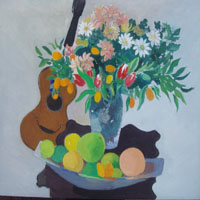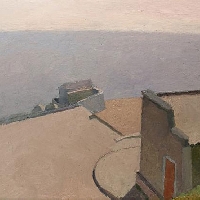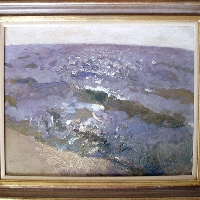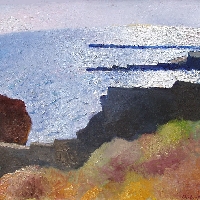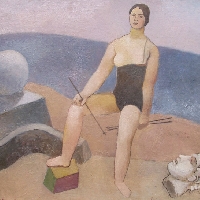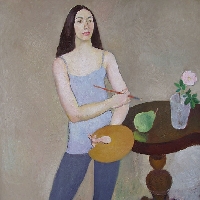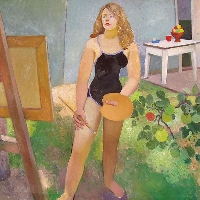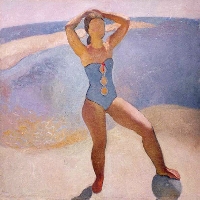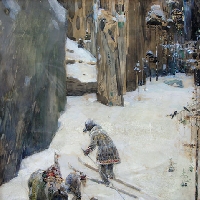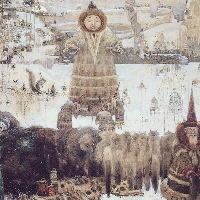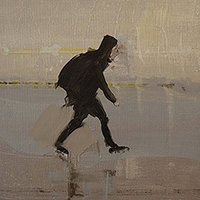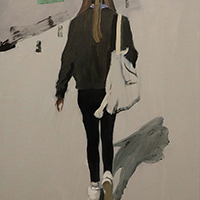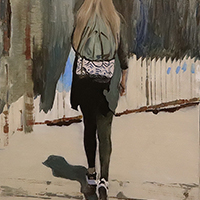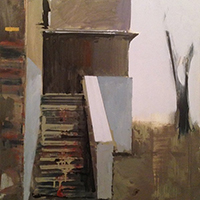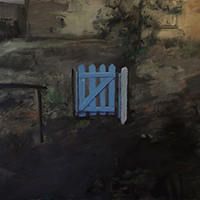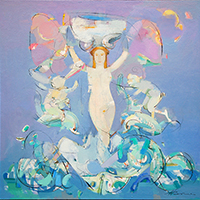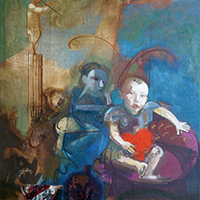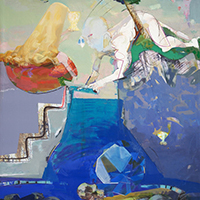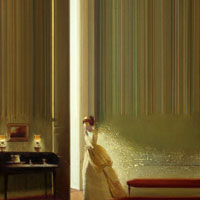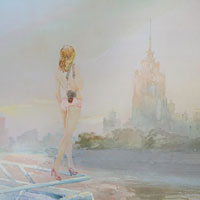(1926 - 2008)
"Yegorov may be one of the more interesting of the Soviet artists to be seen in London to date".
Keith Patrick - ARTLINE Magazine, London, 1990

Yegorov (born in 1926) is one of the most remarkable artists of the 'Odessa School of Art'. In 1946 he was accepted into the 4th grade of the Odessa College of Fine Art where he studied under T.B. Fraierman. He then studied at Repin's and Mukhina's Art Institute in St. Petersburg.
He is well represented in museums and private collections throughout the former USSR and internationally.
SOLO EXHIBITIONS:
1961 The Odessa Art Gallery
1976 The Odessa Art Gallery
1977 The Artists' House Moscow
1987 Central Exhibition Hall,St. Petersburg
1989 Central Exhibition Hall, Moscow
1990 Red Square Gallery, London
1991 Red Square Gallery
1998 The Sea Gallery, Odessa
2001 The White Moon Gallery, Odessa
2001 Solo Exhibition "Ten Years On , New Paintings" - The Air Gallery, Mayfair, London W1, England
2006 Exhibition - "Yegorov at 80", Paintings and Drawings. Odessa Fine Art Museum and Gallery, Odessa, Ukraine
SELECTED GROUP EXHIBITIONS:
1955, Regional Exhibition, Odessa
1957 Young Artists, The Youth Festival, Kiev
1957 Young Artists, Moscow
1957 Odessa artists (Yegorov, Atzmanchuk, Lomykin, Vlasov)
1957 Regional Exhibition, Odessa
1957 Ukrainian Art, 40th Anniversary of the Great October Revolution
1959 Exhibition of Graphic Arts, Odessa
1960 Regional Exhibition, Odessa
1960 "Soviet Ukraine", Exhibition in Moscow and Kiev
1961 Republican (Ukraine) Exhibition, Kiev
1962 1st Regional Exhibition of Oil Studies, Odessa
1963 2nd regional Exhibition of Oil Studies, Odessa
1964 Regional Exhibition, 20th Anniversary of Odessa Liberation from German Occupation
1966 "Odessa-Varna-Buragas" - Exhibition of Odessa Artists in Bulgaria
1967 Regional Exhibition, 50th Anniversary of October Revolution, Odessa
1968 All Union Exhibition, 50th Anniversary of Komsomol, Moscow
1969 Exhibition, 175th Anniversary of city of Odessa, Odessa
1970 Regional Exhibition, Odessa
1971 Odessa Artists, Moscow
1972 All Union Exhibition, Moscow
1972 1st Republican (Ukraine) Exhibition of Drawings, Kiev
1972 Odessa Artists, Kiev
1973 1st Regional Exhibition of Drawings, Odessa
1973 Regional Exhibition of Tapestries, Odessa
1974 Regional Exhibition, 30th Anniversary of Odessa Liberation from German Occupation
1976 Odessa Artists, Kishenev, Moldova
1999 Exhibition of Odessa Artists, Halls of Union of Artists, Kiev
2004 Exhibition - "Odessa School of Art Today". Odessa Fine Art Museum and Gallery, Odessa, Ukraine
Yuri Yegorov
The Black Sea is transformed into the mercurial opalescence of a nacreous globe, turning away into the late afternoon shimmer of a setting sun. The sea is as much a character in the work of Yuri Yegorov as the caryatid-like women and simple fishing boats; calm and sparkling like a shower of pearls, or vigorous and turbulent, riffled by waves, it functions as an archetypal glyph for the force of nature. The women in Yegorov's paintings also fulfil a symbolic or mythic function, their solidity and stature alluding to the ancient stone statues found in the countryside of the Ukraine, figures which embody the presence of the mother goddess of pre-Christian religions, a goddess of the earth and the seasons, denoting the cycles of birth, death and regeneration.
There may be superficial resemblances in Yegorov's work to the early Blue, Rose and neo-Classical periods of Picasso's oeuvre - with his stout women and classicised poses - but a much closer resonance is found in the work of Balthus. In particular Yegorov's interiors with a single standing figure have a great affinity with many of Balthus' similar compositions such as The Moth of 1959 and Nude in Profile of 1977. Both share the same frieze-like patterning of space and simplified forms, but whereas Balthus' nudes smoulder with a pungent and dangerous eroticism, Yegorov's women achieve a balanced and serene poise, the often elongated figures reminding one of the stately Virgins of El Greco. The model may have been his wife or daughter but theses figures stand for all women, they are not so much portraits as portrayals of the essence of the feminine.
A prominent member of the Odessa Group, Yegorov's work is well known and collected throughout the former USSR and in Europe and America. He first showed in London ten years ago at the Red Square Gallery where his work received an enthusiastic response. Now in his seventies Yegorov has demonstrated that there is no weakening of his command of his chosen medium. The work in this exhibition demonstrates his continuing mastery of the fundamental elements of painting: space, light, colour, structure, symbol and surface. There is a new clarity and simplicity in the recent work, a coherent rendering of the lucid light of his native Odessa. Subtle greys and muted blues and browns are played off against vibrant primary hues and succulent oranges and greens. In the still-lifes the repeated appearance of the six-sided conic object and the abstracted spheres of the fruit remind us of Cezanne's dictum about reducing all forms to the cylinder, the cone, the sphere and the cube.
The pictorial space is flattened in the still-lifes by tipping the surface of the table towards the viewer, the same mechanism we find at work in the paintings of Braque and Picasso during the late cubist period. In the sea-scapes the same flattening of space is achieved by placing the horizon at the very top of the picture, this has the effect of privileging the surface of the painting over any evocation of illusionistic space. This modernist concern is further reinforced by the tactile application of the paint in a thick and sensual impasto, drawing attention to the surface. It is the pictorial space rather than the depicted space which is important to the artist, and it is these concerns which place Yegorov's oeuvre firmly in a modernist tradition stretching from impressionism and cubism to contemporary artists such as David Hockney and Lucian Freud.
Richard Dyer © 2001
Art critic, reviewer and contemporary art collector, has written for Flash Art, Frieze, Third text, Art Press, Time Out, The Guardian, Rapid Eye and many other publications. Assistant editor of Third |Text magazine, Managing Editor of the international literature and art magazine Wasafiri. An editor of Ambit magazine and London correspondent for the French cultural magazine Citizen K.
As the barriers between the East and West fall, it is inevitable that the art from both sides will meet. And in that meeting there will be many lessons to be learnt. For Eastern artists, the first lesson must be that the streets leading to the Western galleries are not paved with gold, that recognition within the capitalist art market is hard won. For us in the West the lesson is more subtle. Looking across the divide to a tradition that has been fragmented and suppressed by a totalitarian orthodoxy, it is all too easy to dismiss the results as reactionary in the most academic sense. The Soviet tradition has been starved of communication - of art education, exhibition facilities, international exchanges and contemporary magazines. It has understandably retreated into formal cliches which, for the most part, echo the early years of this century.
Yet, in their enforced isolation, Soviet artists of note have retained a sense of identity that the internationalism of the West has lost. That sense of regionalism and the identification of the artist with immediate, cultural concerns, is what at best distinguishes contemporary Soviet art from its Western counterpart. Admittedly, most Soviet artists appear unable to translate that feeling into an adequate visual language, perhaps, through no fault of their own, because access to the rich development of 20th Century art has been denied. But even so, occasionally an artist emerges that appears to have that coherent individual voice. Yuri Yegorov may be one such artist.
Yegorov is now 64 and, despite being a member of the Union of Artists since 1957, has retained an individual identity that is matched with the sound understanding of his craft. Because of this, Yegorov's career has not been rewarded with the accolades which his own country reserves for artists who have towed the Party line. But for a Western audience, it is difficult to see why Yegorov's art should not be acceptable to the most conservative of censors. Formally, his work derives from the vague area between Renoir's more voluptuous nudes and Picasso's Blue or Rose Period, with perhaps an occasional nod in the direction of the neo-Classical nudes which Picasso painted in the '20s. The most powerful works are certainly the paintings of female figures, often solitary, maternal and monolithic, with the expanse of the Black Sea serving as a back-drop. These work best when the subject is least explicit, when peripheral detail is reduced to a minimum, and it is at such moments that we glimpse that Yegorov's painting has the potential to reach toward particular cultural references. On the most general level, there is something too earthy and too heavy thighed about the physiognomy of these women to fit comfortably into our own culture. These nudes are not sex symbols so much as maternal figures. More explicitly, they owe something to the 'Babas', the ancient figures which are to be found in the countryside of Yegorov's native Odessa. Stripped of the model's identity, they surface as powerful archetypes, born of a culture which appears closer to the earth than our own.
Although only a part of the artist's output, these female figures have a lasting impression, a resonance which suggests that Yegorov may be one of the more interesting of the Soviet artists to be seen in London to date.
Keith Patrick Editor of Contemporary Visual Arts. "Art Line" magazine, October 1990.

